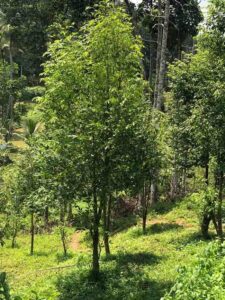One of the costliest perfumes in the world, oudh is made from a critically endangered tree species, whose cultivation is gradually gaining popularity in Kerala.
During Eid, the streets of Saudi Arabia, Qatar and many other Arab countries are filled with a musky fragrance, the same smell that pervades certain areas of Mecca and Medina. It comes from the scented oil aoud or oudh. One of the costliest perfumes in the world, it is also known as liquid gold considering its price. Oudh is made from a critically endangered tree species, whose cultivation is gradually gaining popularity in Kerala.

High demand leading to unsustainable collection methods
Just one drop of the oil produces a heavenly fragrance. In Arab countries, people claim that the smell makes them happy as it is the scent of heaven. The wooden chips are smoked inside clothing due to which the scent remains on the outfit for days. It is also said that the scent of oudh varies each time it is smelt.
The global market for oudh runs into US$ 6 to 8 billion annually. This fragrant wood, also called the ‘wood of the gods’ by certain communities, is critically endangered due to its demand. Living for more than a century, over time the trees get the fungal infection that produces agarwood. A documentary titled Scent from Heaven by Al Jazeera revealed that only 2% of the Aquilaria and Gyrinops trees originally produced agarwood. Now, they are being indiscriminately felled as it is difficult to know from the outside if a tree has agarwood. Indian oudh (wood chips) costs around US$ 5,000 per kg in Qatar while Cambodian oudh, considered higher quality than Indian oudh, sells for around US$ 34,000 in markets in Arab countries.
In the documentary, journalist Ali Mohamed al Woosain says that due to the high demand, there are mafias running a black market for oudh. He adds that people even get killed in the hunt to find the rare agarwood trees. Along with exploring the magical beauty of oudh, the documentary shows how it is collected through unsustainable methods that have led to massive destruction of the trees.
So original agarwood appears in these trees during the course of 100 or 200 years. In a few instances the fungus has appeared after 50 years. In this background, what is the scope of agarwood cultivation? What do agarwood farmers in India do? A resin compound is artificially injected into the trees after 7 to 10 years of growth. This substance accelerates the growth of agarwood in the trees through fungal infection. This approach is, in a way, more sustainable than felling the trees to find original agarwood.
Assam is the agarwood capital of India, from where the technologies and saplings came to Kerala.
Agarwood farming

“It might take many decades for the development of the specific fungus. It can be due to an insect attack or any other infection. To defend against this infection and protect itself, the tree produces a resin. This is called resinification. The wood becomes dark in colour and is fragrant if smoked. This agar or oudh, which can be extracted through hydro distillation or steam distillation or carbon dioxide extraction methods,” he said.
But Shamsudheen said that in artificial inoculation, the harvesting period is around 8-10 years, as many people have taken to cultivating it recently. “A 10-year-old tree can yield up to 10 kg of useful wood. About 70 kg of wood can produce 20 ml of oudh oil. The cost of 1 kg of good quality resinous agarwood is about UD$ 20,000,” he added.
The Kairali Agarwood Farmers Association (KAFA) located in Kannur district’s Angadippuram has around 75 members.
“We have farmers who own one tree to 3,000 trees. I have around 4,000 trees, including 1,000 trees in Karnataka. They are just 5 years old, after another 2 years the resin can be injected,” Saji P Eliyas, president of KAFA says.
“The saplings are easily available now. Each sapling needs to be planted in a 1.5-metre-deep pit filled with manure. It needs care in the initial few months… the soil should always be hydrated. There is a possibility of worm attack or root damage, so we may need to use pesticides,” he added.
Saji said that some farmers in the association have already sold their trees. However, he is planning to start a production unit to process the oil and chips. “By the time I can harvest, I want to start a manufacturing unit rather than sell the trees. But small-scale farmers are selling the tree as such,” he explained.
The Kerala farmers are in constant touch with farmers in Assam for support. “The injecting compound is brought from Assam. After a lot of research, they have created many products that can be used for injecting,” he said.
Saji said that KAFA members support each other by sharing information on new research findings in the field. “It will not be very difficult to export the cultivated agarwood. It has a good market inside and outside India,” he noted. #HydTravel #hydnews
